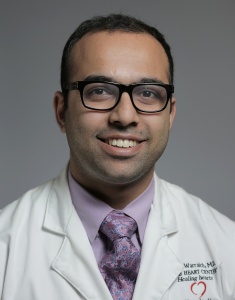 Haider Warraich, MD, a cardiovascular diseases fellow, has an essay in today's New York Times about the parallels between the beginning and end of life. Take a moment to read an excerpt below and find the full article here.
Haider Warraich, MD, a cardiovascular diseases fellow, has an essay in today's New York Times about the parallels between the beginning and end of life. Take a moment to read an excerpt below and find the full article here.
Like many new fathers, I spend as much of my free time as I can get away with gazing into my baby daughter’s eyes as she stutters and scans. I remember a day not long ago when I rocked my daughter, Eva, in my arms, and her eyes stopped and steadied as they looked back into mine. Her arms and legs ceased to rock and her entire body just relaxed. A chill went down my spine.
I felt that for the first time, she had really seen me. She was about 3 months old at the time. Within moments, though, her eyes left mine and started whirring around in their sockets again. While this was the first time I had shared such a moment of joy coupled with disappointment with her, I had experienced this many times with patients at the end of life.
Many have alluded to the symmetry of the beginning and the end of life. Most people, however, become parents long before they become caregivers. For me the order was reversed. For while I only recently became a father, medical training has made me much better acquainted with those at the opposite end of the spectrum.
The agony of death is more than just physical – it is an existential wound that gnaws away until there is slow, and frequently unwilling, acceptance of the inevitability of one’s mortality. I sometimes see a similar pain in my baby girl’s eyes as she makes another arduous journey – learning how to be alive. Frequently, as she cries when she is hungry, or cries when she is overfed, or cries as she tries to have a bowel movement, or just cries, it seems as if she is yearning to go back to the simple comforts of her mother’s womb.